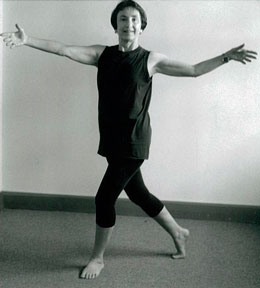Moving through Life
by Odile Atthalin
I arrive early and jog around the sunlit studio, enjoying the CD Sacred Earth Drums by David and Steve Gordon. By 9 a.m. our circle has formed, ten women and men ages 30 to 80, greeting one another for a morning of RosenDance.
Based on teachings developed by master physical therapist Marion Rosen in the 1960s, my class in Berkeley, California, offers safe, gentle movement to music, progressing from small, simple moves to larger, more complex ones. Rosen, who died at 97 and taught movement until she was in her 80s, called her method “physical therapy in reverse” because she created it in response to clients asking how they could avoid needing physical therapy.
Class starts with Bob Marley’s reggae classic “One Love,” to accompany moves that lubricate our joints as we bend, swing, sway, rotate, jiggle, and twist. We move our hips, feet, and leg muscles to the sensual tunes of South Pacific panpipes, exploring our range of motion. Switching to slow Leonard Cohen songs for deeper stretches, we expand our chests and loosen our diaphragms, allowing more breath, enlivening the core of our bodies. For an element of surprise, I vary the music and moves with every class.

We pause for breath and feelings between segments. Mindful repetitions create familiarity and ease. No worrying, no trying hard. We are in the flow, and it’s a wonderful feeling. Moving in a circle, we partner with another and share the mood brought on by the music. Community and camaraderie builds. For an introvert like me, it’s my weekly dose of gregariousness.
Ready for larger movements, we try a grapevine sequence to upbeat Motown rhythms. Then we dance across the floor to the lyrical flute of James Galway, moving in different combinations and directions, focusing on balance and fun.
I model the moves and name each part of our bodies involved. My words are simple; my voice conveys ease and playfulness. These verbal cues keep us focused on what we sense and feel as we move. This is a work-in more than a work-out. As Marion Rosen says, “Timing that allows you to be aware of the impact of movement on the inside is very different from mindless performed movement.” Best known for her internationally renowned bodywork technique—the Rosen Method—Rosen also developed a movement method with similar goals. As the bodyworker’s touch facilitates opening and releasing through layers of chronic tension, so does the practice of moving consciously. Added benefits include increased flexibility, range of motion, and physical and emotional awareness.
To end class, we sit on the floor back to back with a partner, sensing and flexing our backs; then we lie down, and as we listen to haunting Buddhist chants, we roll and twist from side to side, enjoying our spine in contact with the floor. We assimilate the experiences of the previous segments, relax deeply free of stress, and allow all parts of ourselves to come together in embodied self-awareness.
RosenDance is an ideal movement practice for anyone who wants to move consciously, well into their 80s. Medical research continues to show the benefits of moving to music: it builds new neural pathways, makes us steadier on our feet, and protects us from falling.
“Every movement can be a dance,” says Rosen. “To use movement as a dance, to dance through life, that is really our goal.”
